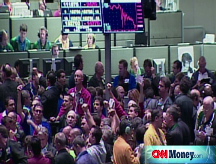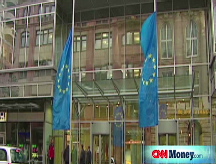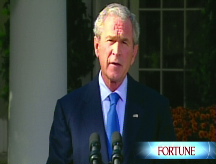Raging bulls
Dow jumps 936 points and S&P up 104, in the biggest point gains ever. The Dow, S&P and Nasdaq all gain over 11%.
 |
| Dow ends 936 points higher, the largest points gain ever. |

NEW YORK (CNNMoney.com) -- Stocks rallied Monday afternoon, with the Dow rallying 976 points during the session, as investors bet that the worst of the credit crisis is over, following a series of global initiatives announced over the last few days.
The Dow Jones industrial average (INDU) ended 936 points higher, after having risen as much as 976 points during the session. The advance was the largest ever during a session on a point basis. The point gain was equal to 11.1%, the best one-day percentage gain since Sept. 1932 and the fifth-best ever.
The Standard & Poor's 500 (SPX) index added 104 points, its best one-day point gain ever, equal to 11.6%.That was also the best percentage gain since Sept. 1932 and the fourth-best overall.
The Nasdaq composite (COMP) added almost 195 points, the 10th best day on a point basis. The gain of 11.8% was its second-best ever, after a gain of 14.2% on Jan. 3, 2001, right near the end of the tech bubble.
Stocks were buoyant Monday as investors welcomed a global effort to unfreeze the credit market and get money flowing through the system again. Although stocks reacted positively, credit markets barely budged.
"We had some good news this morning from the Fed and the other central banks, but we were also oversold on an historic level and due for a big bounce," said Ryan Detrick, senior technical strategist at Schaeffer's Investment Research.
Monday's rally increased market value by $1.2 trillion, the largest single-day paper value gain ever according to an advance in the Dow Jones Wilshire 5000, the broadest measure of the stock market. That cut in half the $2.4 trillion in market value the Wilshire lost in the recent 8-session bloodletting.
Last week was the Dow's worst ever, ending a stunning eight-session selloff that seared 2,400 points off the blue-chip indicator. That represented a 22% decline in the Dow, something not seen since at least the '30s.
Detrick said that not only had the Dow fallen for eight straight sessions, but it had also fallen for eight straight weeks.
"We basically saw a crash, and so you're going to see a big bounce off that," he said.
That bounce was predicated by the day's news, with investors breathing a sigh of relief that some specifics were finally released regarding the $700 billion bank bailout.
"But the devil will be in the details, in terms of what we hear tomorrow," said Chris Johnson, CEO at Johnson Research Group. On Tuesday, the Treasury Department is expected to release more specifics on the bailout.
Whether the rally can continue beyond the short-term is unclear, as analysts debate whether the market really put in a bottom on Friday.
Johnson said he's not convinced. He equated Monday's rally to a beach ball that has been pushed further and further under the water, where it builds up so much pressure that when it is finally released, it bounces.
"We saw a lot of desperate selling over the last few weeks and at some point, these stocks start to look attractive," Christopher Colarik, portfolio manager at Glenmede Investment Management.
Previous efforts to get the credit markets moving again had failed to reassure investors, but the latest developments seemed to provide reassurance.
"Seeing that there's going to be more of a global commitment to resolving the financial crisis has given confidence to investors and gotten them to put some money to work," Colarik said.
Movers: Gains were broad based, with all but 3 of the Nasdaq 100 (NDX) gaining and all but 1 of the Dow 30 rising.
The Dow's biggest gainer was General Motors (GM, Fortune 500), which surged 33% after having been hit hard in the recent selloff. GM has reportedly held talks with Chrysler about a possible merger, although analysts say GM would need to raise cash ahead of any potential deal.
Other Dow gainers included Alcoa (AA, Fortune 500), up 22.8%; Chevron (CVX, Fortune 500), up 21%; Microsoft (MSFT, Fortune 500), up 18.6%; and American Express (AXP, Fortune 500), up 18%.
The Dow's lone decliner was General Electric (GE, Fortune 500), which reported weak quarterly earnings late Friday. It was also among the 18 components of the S&P 500 that didn't join the rally.
Other S&P losers included a number of homebuilders and bank sector stocks.
One notable exception in the financial sector was Morgan Stanley (MS, Fortune 500). Morgan gained 87% after it said it had completed plans to sell a 21% stake in itself to Japanese bank Mitsubishi UFJ for $9 billion.
Market breadth was positive. On the New York Stock Exchange, winners topped losers by over 18 to 1 on volume of 1.82 billion shares. On the Nasdaq, advancers beat decliners by over 5 to 1 on volume of 2.67 billion shares.
The latest: On Monday, Neel Kashkari, assistant Treasury Secretary and interim head of the $700 billion bailout program - outlined some of the steps the government will take in the weeks and months ahead. The program includes buying soured mortgage assets from banks and buying stock in a number of financial institutions. (Full story)
Meanwhile, House Democrats are meeting Monday to put together a second economic stimulus package that could be worth $150 billion, although House Republicans are reportedly skeptical, CNN reports.
World leaders met over the weekend to come up with solutions. After an emergency meeting Sunday, 15 European nations agreed to help their troubled banks by adding capital and guaranteeing inter-bank lending. (Full story)
Additionally, the British government said it would pump $63 billion into three of the country's banks.
And the U.S. central bank said it will offer an unlimited amount of dollars to three other central banks in an effort to keep money flowing. (Full story)
The Fed announced an emergency rate cut last week, has pledged to help U.S. companies by buying short-term debt directly from businesses and has made billions available to banks in return for damaged assets.
Credit markets still frozen: The recently announced initiatives made a small dent in the lending freeze Monday, although conditions remained tight.
The three-month Libor, or what banks charge each other to borrow for three months, eased to 4.75% from a 2008 high of 4.82% Friday.
The Libor-OIS spread, a measure of cash scarcity, eased to 3.61% from a record 3.67% Friday, suggesting cash is more available than at the end of last week.
The TED spread, which is the difference between what banks pay to borrow from each other for three months and what the Treasury pays, fell to 4.57% after spiking to an all-time high of 4.65% Friday.
The wider the spread, the more reluctant banks are to lend to each other, rather than from the federal government. When markets are fairly calm, banks charge each other premiums that are not much higher than the U.S. government.
Treasury bond markets are closed Monday for Columbus Day. (Full story)
Other markets: U.S. light crude oil for November delivery settled up $3.49 to $81.19 a barrel on the New York Mercantile Exchange. On Friday, oil prices plunged more than $8 to a 13-month low. (Full story)
Oil prices have tumbled on bets of slowing demand since the price of crude hit an all-time high of $147.27 a barrel on July 11.
The price of gas decreased for the 26th consecutive day, according to a survey of credit card activity by motorist group AAA.
COMEX gold for December delivery tumbled $16.50 to $842.50 an ounce.
In currency trading, the dollar slipped against the euro and the yen. ![]()




